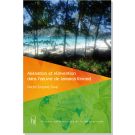Aliénation et réinvention dans l'œuvre de Jamaica Kincaid
L’écriture caribéenne entretient un double rapport avec la culture des anciens colons, oscillant entre résistance et imitation, déterritorialisation et reterritorialisation, aliénation et réinvention. Jamaica Kincaid est dans une relation dynamique avec son héritage littéraire et historique...
Caribbean literature maintains a dual relationship with the culture of the former colonizers, hesitating between resistance and imitation, deterritorialization and reterritorialization, alienation and reinvention. Jamaica Kincaid’s connection with her literary and historical heritage is a dynamic one. Her writing is postcolonial in the political more than the historical sense. Like Kincaid herself, the characters explore the boundaries between filiation and affiliation, adopting strategies of reappropriation to respond to their alienation in their relationships with their mothers. Their reclaiming of their bodies leads to self-reinvention, and to the reappropriation of history and space. Kincaid herself searches for an artistic space in which to reinvent herself. She combines photography, painting, and gardening with writing, adopting different strategies for reappropriating and decolonizing language. She writes in the oppressor’s tongue and subverts it, combining different voices in the space of her texts.
L’écriture caribéenne entretient un double rapport avec la culture des anciens colons, oscillant entre résistance et imitation, déterritorialisation et reterritorialisation, aliénation et réinvention. Jamaica Kincaid est dans une relation dynamique avec son héritage littéraire et historique. Son écriture se veut postcoloniale au sens politique plus qu’historique du terme. À l’instar de Kincaid elle-même, les personnages kincaidiens explorent les limites entre filiation et affiliation : face à l’aliénation de la jeune fille dans la relation à sa mère, elle met en place des stratégies de réappropriation. Réappropriation du corps, qui mène à la réinvention du moi, mais aussi réappropriation de l’histoire et de l’espace. Kincaid est elle-même à la recherche d’un espace artistique dans lequel se réinventer : photographie, peinture et jardinage se mêlent ainsi à son écriture, et s’ajoutent à diverses stratégies de réappropriation et de décolonisation de la langue. Elle écrit dans la langue de l’oppresseur et la subvertit, introduisant ainsi un enchevêtrement de langues différentes dans son espace textuel.
| Year of publication | 2014 |
|---|---|
| Author | Nadia Yassine-Diab |
| Format | 16 x 24 |
| ISBN | 978-2-36781-113-0 |
| ISSN | 2118-3023 |
| Number of pages | 336 |
| Editor | Presses universitaires de la Méditerranée – PULM |
| Language | French |
| Type of book | Paperback, perfect binding |
| Date of availability | Dec 12, 2014 |
| 8 sens stock quantity | 7 |
| Weight | 0.720000 |
Also in collection








